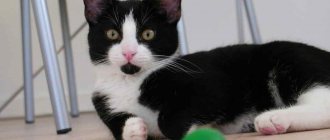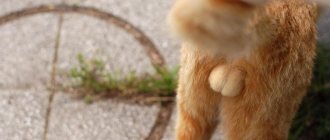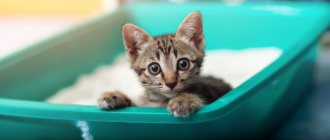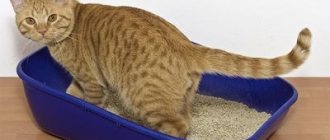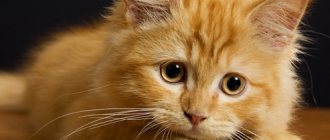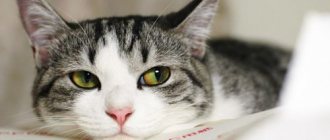Symptoms Causes Diagnosis Treatment. What to do if your cat has urinary incontinence? Bladder problems (urinary incontinence in cats) are usually caused by a weakened bladder or due to partial obstruction in the bladder. Owners of cats and cats may perceive this type of violation as spontaneous urination - that is, they may think that the cat deliberately leaves puddles in the wrong places. Urinary incontinence is more common in middle-aged, old, and large breed cats.
The cat stopped going to the litter box, what should I do?
Urinary incontinence in cats is divided into several types, according to the nature of the manifestations:
- The cat's urine is constantly flowing in small drops. The cause of this disease is a weakening of the muscles that control the sphincter. Another reason is weak bladder muscles that are unable to stretch and contract.
- The inability to tolerate is called urge incontinence. Urine excretion occurs spontaneously as soon as the pet feels the urge. Such animals do not have time to reach the tray, but strive towards it.
- Stress incontinence has nothing to do with psychological stress. This refers to a sharp increase in pressure in the abdominal cavity, which leads to urination. In such animals, discharge can occur, for example, from a sharp jump.
- Reflex discharge occurs when the pet does not feel the urge to pee. Emptying occurs reflexively.
- Nocturnal inability to hold urine, as the name suggests, occurs at night when the pet is sleeping and cannot control the urge to pee.
If there is any suspicion of a disease, the owner should contact a veterinarian.
Causes of urinary incontinence
Neurogenic
Caused by a malfunction of the nervous system, which can occur from injuries, tumors and hernias in the spine or brain. Nerve endings are pinched or ruptured, so their conductivity is disrupted.
Structural anomalies
They can be congenital (hypoplasia, ectopia), acquired (urethral and bladder stones, formation of urethrovaginal fistulas, etc.).
Functional disorders
Occur due to diseases affecting the functions of the excretory system. So, with urinary tract infections, inflammation of the walls of the bladder and urethra occurs, so the contractile activity of the bladder is disrupted, it becomes hyperactive.
With stones, tumors of the bladder, kidneys, adrenal glands, acute urinary retention may occur in a cat. Cystitis and nephritis are also accompanied by urination problems.
Factors such as proper pet maintenance, feeding regimen, and lack of stress are very important. Too fatty or spicy foods make the urine more alkaline, which can lead to itching, burning of the urethra, and inflammation of the upper parts of the urinary system. Therefore, it is strictly forbidden to feed an animal with food from our table.
Your cat doesn't like the type of litter box you have.
It's time to take another look at cat establishments.
Maybe the litter box has a cover that traps odors or restricts her movement so she can't get into a comfortable position to pee without pressing part of her body against the inside of the cover, which many cats don't like.
Or it could be a medical problem combined with a poorly fitting cat litter box. If your cat has arthritis, the sides of the box may be too high, making it difficult to get in and out.
Symptoms
With night incontinence, the pet wakes up “in a puddle”; with urgent incontinence, the pet does not have time to run to the litter box. Reflex voiding is the most noticeable: the animal can urinate anywhere at any time.
The owner needs to analyze the general condition of the animal, for example, lethargy, drowsiness, aggressiveness or irritability. Other behavioral disorders: anxiety, refusal to go to the litter box or, conversely, frequent visits to the toilet, also require attention. Pink urine in a cat, the presence of mucus and impurities in it, is an important “bell” to immediately consult a doctor. Do not try to treat the animal yourself. Only after a complete examination and passing all tests can treatment be prescribed.
Examination by a veterinarian
The doctor needs to tell all the symptoms that the owner noticed. During the examination, the veterinarian will perform palpation, which can be used to identify large tumors and organ development abnormalities.
In case of incontinence and other urological disorders, a urine test will be prescribed, most often microscopy of the sediment will be required. Previously, we have already given a detailed explanation of a urine test for a cat. If necessary, ultrasound and x-rays are also performed.
Additional studies may be needed, such as a blood test, microflora culture, and analysis of renal epithelium in the cat’s urine.
Important: obvious neurogenic disorders such as injuries, tumors, spinal hernias, and urinary disorders are treated by eliminating these factors.
In cases of functional disorders, a complete and comprehensive examination cannot be avoided. Only a complete collection of all indicators will make it possible to correctly diagnose and correctly prescribe treatment.
During the examination, the veterinarian will recommend using special diapers for animals. There should always be a clean, absorbent diaper on the sleeping area. These care items are sold at any pet store.
Important: do not scold your pet for its inability to tolerate, do not punish it under any circumstances. A stressful situation will only harm the animal, but affection and care, on the contrary, will help cope with the disease.
Feline enuresis? (Not at night, but during sleep)
Answers:
Shinshik
no longer has cystitis, your boy is just aiming! traumatic injuries contribute to the apartment was so frightened of something that only made things worse. Human using homeopathic and
good
caudal vertebrae. The disease is urethritis, medications for it, consult the animal to control the discharge, but the cat is much more mature) ) of the spinal cord, hyperextension is marked. . and incontinence do not give medications to the cat.. homotoxicological drugs. In the back and head, the sales veterinarian helps quite effectively. Urine. Worse - feline urological syndrome, it is necessary to castrate or caudal vertebrae. The disease of the new balcony... cannot be cured by itself. Out of hopelessness, in emergency cases, the brain can also be treated with Baytril, or some Poor cat. What is this? Etiology. Urinary incontinence often leads to girls to drive it back and head and clothes, underwear do not tell that I can only advise a surgical operation. lead to incontinence another antibiotic, but this does not even develop against the background of death As a result, constantly) the brain can also but USK (urological acute renal failure. Show the cat to the veterinarian. More likely it will lead to terrible incontinence. .that’s why I don’t STOP CYSTITIS (sold in in the village there are no Symptoms. Cats suffering from usually baytril. Call
Alice M.
may be from the syndrome), alsoNovernoe if you would only prescribe injections, urine.And then they castratedI love cats and
We get tested
It is better to take any tests in the morning on an empty stomach. The only exceptions are emergency cases, if the pet suddenly becomes ill and needs emergency hospitalization.
Donating blood is easy: the veterinary nurse will find a vein and take a portion of blood without any problems.
Many owners are concerned about the question of how to collect urine from a cat for analysis. To do this, prepare a tray: remove the filling, wash it, and pour boiling water over it. There is no need to use aggressive detergents such as bleach. Even if the pet doesn’t like the empty tray, sooner or later he will go into it. Drain the liquid into a jar and take it to the clinic.
If your pet does not have time to reach the tray, put a diaper on it. Later, squeeze the diaper into a jar for analysis. But this option is not very good, since the composition of the diaper can change the composition of the urine.
Another option: go to the clinic. To take the test, the doctor will insert a catheter. Catheterization is not very comfortable for the furry patient, but is completely painless. The most accurate and pure material is considered to be obtained by a-puncture of the bladder. The needle is inserted through the abdomen into the bladder, then the required amount of liquid is sucked out. The procedure is easily tolerated by animals; anesthesia or freezing is not required.
Do you need more cat litter trays?
Even if you have a couple of litter boxes, it may not be enough.
Some cats prefer to urinate and defecate in separate litter boxes, and some cats will not share a litter box with another cat.
A good general rule is to have a litter box for each cat in the house, plus one more. And install at least one litter box on each floor of the house if you live in a house.
I probably just said something you didn't want to hear. How – should I clean another cat litter box? I don’t even have time to tinker with these trays!
But it's better than constantly washing your sheets, right?
Multiple litter boxes are an especially good idea for kittens. Just like children, kittens' control over their litter box is not fully developed, so they need a few easily accessible toiletries to prevent puddles and poop on the floor or in your bed.
You should also never scold or punish your kitten or cat, especially when sitting in or near her litter box.
This will create a negative association with the litter box and she will avoid it. For the same reason, never use the litter box as a place to trap your cat in order to give her medicine, trim her nails, or herd her into the litter box.
Urinary incontinence in cats: treatment
Treatment is prescribed by the doctor after a complete history collection. Based on the results of tests and studies, the veterinarian determines the exact cause of the disease. If the inability to endure is caused by trauma, then all efforts are directed towards treating the trauma. The same applies to hernias and tumors: by getting rid of them, it is most often possible to normalize urination. If spinal cord injuries cannot be completely cured, and the inability to control the desire to pee persists, palliative measures are prescribed: homeopathy, physiotherapy, massage, and the use of special rehabilitation means.
If a cat has bloody urine, what should owners do?
It is necessary to bring your pet to a veterinarian as soon as possible, since blood in the urine is a possible sign of many diseases:
- Infections of the genitourinary system. Treatment is usually medication. A course of antibiotics, immunomodulators, and vitamins will put your pet back on its feet and relieve problems with urination.
- Blood impurities in the analysis occur in the presence of stones in the kidneys and/or bladder. Only by curing urolithiasis (urolithiasis), and, if necessary, operating on the animal, can you get rid of blood impurities and incontinence.
- Structural anomalies are subject to surgery. For example, suturing a vesicovaginal fistula will prevent vaginal exudate from entering the urine, and vice versa. By isolating the bladder from the constant causative agent of inflammation, it will be possible to cope with incontinence.
Prevention of recurrence of incontinence in a pet is by maintaining a proper diet, hygiene and an anti-stress environment at home.
Diseases and hormonal storms
Practice shows that puddles on the owner's bed are often left by uncastrated cats and unsterilized cats during hormonal storms, which provoke unwanted behavior. Veterinary pharmacies offer a selection of hormonal medications that will calm the animal. If you do not plan to breed purebred offspring, consider castration or sterilization of your pet.
In the wrong places, cats and kittens can begin with the development of serious diseases of the internal organs:
- urolithiasis;
- intestinal pathologies.
The appearance of puddles on the owner's beds causes inevitable aging of the animal. Older cats suffer from Alzheimer's disease, which is characterized by a loss of toilet skills. The owners can only understand and forgive the aging animal.
